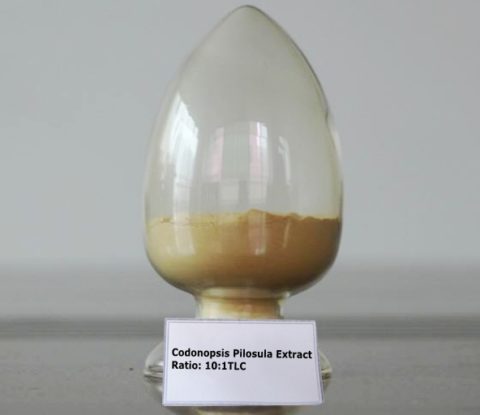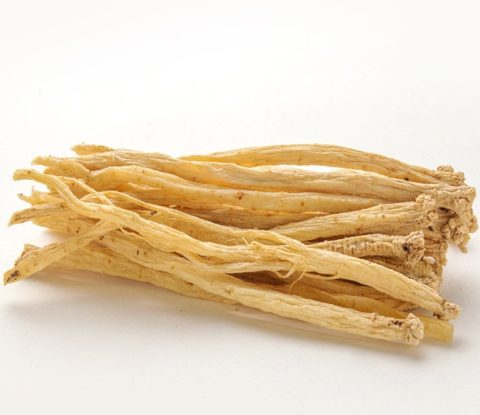
Codonopsis Pilosula Extract
【Other names】: Dang Shen, Radix Codonopsis, Szechwon Tangshen Root, Moderate Asiabell Root, Pilose Asiabell Root
【Latin name】: Radix Codonopsis
【Part used】: dry root
【Spec.】: 10:1 20:1
【Test method】: TLC
【Particle size】: 95% pass 80 mesh size
【Appearance】: Brown-yellow powder
Brief Introduction
Codonopsis Pilosula is a herb belonging to the family of Campanulaceae and is also known as Dangshen (not to be confused with Danshen, a name for the herb S-alvia miltiorrhiza) that is commonly used in Traditional Chinese Medicine; where it is most well known for being a low-cost substitute for Panax ginseng, where some historical texts falsely call Codonopsis ‘Chinese Ginseng’. Codonopsis Pilosula is sometimes found to be mixed with Campanumoea javanica in the same plant family as an adulterant. Codonopsis Pilosula has intentionally been used itself mostly for a spleen and lung tonic, as well as a digestive aid targeted towards the stomach.
Composition
The following bioactives are found in Codonopsis Pilosula:
-Codonopilates A-C, a group of triterpenyl esters isolated from a CHCl3 fraction
-24-methylenecycloartanyl linolate and 24-methylenecycloartan-3-ol, structurally similar to Codonopilates
-Codotubulosine A and B at 0.516-3.44mg/g dry weight, respectively. The variant of modesta has a lesser content (0.14-0.42mg/g) as well as Codonopsine and Codonospinine
-Codonopyrrolidium B, a pyrrolidine alkaloid
-Hesperidin
-Alpha-spinasterol
-N-hexyl beta-sophoroside
-Lobetyolin and lobetyolinin
-5-hydroxymethylfurfural
-Perlolyrine
-Taraxerol, taraxeryl acetate, and 14-taraxeren-3-ol
-Squalene
-Adenosine at 0.885-0.92mg/g dry weight
-beta-sitosterol and beta-daucosterol
-Vitamin E (as alpha-tocopherol)
Main bioactives that may underlie bioactivities of Codonopsis Pilosula, most likely the alkaloids; although Codonopilates are large structures with side chains, all other alkaloids (Codonopyrrolidium B, Codotubulosine A and B, Codonopsine and Codonopsinine) have pyrrolidine alkaloids structures, similar to Piracetam and the racetam family.
Indications in Traditional Chinese Medicine
1. Syndrome of lung-spleen qi deficiency
This herb is similar but inferior to Ren Shen, with the action of invigorating lung-qi and spleen-qi, and neither dry nor greasy in nature. Therefore, it is indicated for all syndromes (symptoms) caused by deficiency of spleen-lung qi. For the light syndrome of spleen-lung qi deficiency, Dang Shen is substituted for Ren Shen in the formula such as Si Jun Zi Tang, Bu Zhong Yi Qi Tang, Gui Pi Tang. For weak physique, lassitude, poor appetite, loose stool and other symptoms due to spleen-qi deficiency, it is usually combined with spleen-tonifying and damp-removing herbs, such as Bai Zhu, Fu Ling. For anal prolapse, long-term diarrhea, prolapse of internal organs caused by collapse of middle qi due to spleen-qi deficiency, it is combined with qi-tonifying and yang-raising herbs, such as Huang Qi, Sheng Ma. For cold-pain in stomach and abdomen, vomiting or diarrhea due to spleen-qi deficiency with cold-pathogen, it is combined with spleen-tonifying and middle-warming herbs, such as Bai Zhu, Gan Jiang. For chronic bleeding due to spleen-qi deficiency failing to keep the blood in the vessels, it can be used singly in large dosage to tonify qi and keep the blood in the vessels or combined with other qi-tonifying and bleeding-stopping herbs in order to enhance the effect. For shortness of breath, cough and dyspnea, difficult in speaking with faint low voice caused by lung-qi insufficiency, it is usually combined with lung-tonifying and asthma-relieving herbs, such as Huang Qi, Wu Wei Zi and Ge Jie.
2. Blood deficiency syndrome or syndrome of both qi and blood deficiency
This herb can tonify qi and blood but is inferior to Ren Shen and is substituted for Ren Shen commonly. It is indicated for blood deficiency due to insufficient qi production caused by deficiency, or blood deficiency syndrome or syndrome of both qi and blood deficiency due to insufficient qi production caused by blood deficiency. These syndromes are manifested as pale or sallow complexion, lassitude, vertigo, palpitation, etc. It is applied together with yin-nourishing and body-fluid-generating herbs, such as Mai Dong and Wu Wei Zi.
Modern Pharmacological Researches
1. Interactions with Neurology
1). Mechanisms
One rat study noted that ingestion of Codonopsis resulted in attenuation of the memory-impairing effects of scopolamine as well as Alcohol (30g/kg) in mice and rats, and was thought to be secondary to a bioactive in the n-butyl alcohol fraction which was shown to increase the density of muscarinic cholinergic receptors in the brain; no binding or alterations in affinity were noted.
Currently, other studies that note interactions with the cholinergic system have found increased tension in the smooth muscle tissue of the stomach, which was partially blocked by Atropine.
Possibly something related to acetylcholine receptors may contribute, but the evidence is currently subpar.
Codonopsis alkaloids were found to suppress cell growth of the neural cell line PC12. Cell growth was suppressed by up to 15% at the concentration of 30ug/mL under the influence of NGF at 2ug/mL; in this study, 100ug/mL of Codonopsis was required to be equally effective as 50ug/mL NGF in suppressing proliferation (to 80% of control).
Codonopsis alkaloids have been found to, in vitro, enhance NGF-induced neuronal outgrowth in PC12 cells. Although it alone failed to enhance neurite length, 2ug/mL enhanced NGF-induced growth from 7.0+/-3% to 52.0+/-8%; 742% the growth of NGF alone. Synergism were noted to be statistically significant at 10ug/mL, and missed statistical significance at 3ug/mL. These benefits appeared to be mediated via MAPK (the pathway mediated by NGF), as incubation with the inhibitor PD98059 suppressed growth. In Schwann cells (RSC 69) it was found that the signalling via MAPK is p38 and ERK dependent, where concentrations of 10-100ug/mL for 16 hours significantly increased proliferation of cell nuclear antigen (up to 120% at 60ug/mL) and increased Schwann cell proliferation around 350% of control at 20-40ug/mL and increased cell migration in a dose-dependent manner coupled with increased MMP9 and uPA, which may be downstream of an increase in FGF-2. The authors hypothesized that the increase of neuronal proliferation and migration could aid nerve regeneration.
Too preliminary to draw conclusions, but some bioactives in Codonopsis (alkaloids in structure) appear to enhance neuronal differentiation in vitro.
2). Neuroprotection
One study assessing brain slice homogenates (in vitro) noted that an extract of Codonopsis pilosula was able to exert anti-lipid peroxidative effects, 8.3-9.8% inhibition with 100-500ug/mL of the water extract but 16.7-30.4% inhibition with a butanolic extract.
3). Interventions
Currently, one human study using Codonopsis in conjunction with Ginkgo biloba at 75mg and 40mg respectively noted improvements in memory aquisition and retention that was greater than an equal dose of Ginkgo Biloba suggesting additive or synergistic effects; Codonopsis was not tested in isolation.
2. Inflammation and Immunology
One in vitro study on a polysaccharide fragment from Codonopsis Pilosula found a dose dependent relationship between splenocyte proliferation in respose to LPS (+77.4%) or ConcavalinA (+75%) treatment. This inflamatory role has been replicated in vivo where a polysaccharide fragment from Codonopsis Pilosula was shown to increase antigen production when administered with a vaccine, suggesting an the fragment can be used as an adjuvant.
One study assessing macrophage phagocytosis found one isolated polysaccharide to, after oral ingestion of 50 or 100mg/kg daily, increase phagocytotic capabilities by 15.6% and 28.7%; respectively. As there was efficacy with the polysaccharide (CPPW1) but not the polysaccharide without side-chains (CPPW1B), the side chains were deemed critical to the immunological function of Codonopsis.
3. Interactions with Cancer
1). Tumor Growth
One in vitro study using the HO-8910 (human ovarian cancer) cell line noted that treatment with an acidic polysaccharide derived from the roots appeared to reduce the invasion and migration potential of the t-umor cell while suppressing proliferation; thought to be through a reduction in CD44 expression, a cellular adhesion molecule that had its expression (as a percentage of total cells) decreased dose-dependently in response to the acidic polysaccharide. Cell survival after 48 hour incubation reached 81.72% of baseline at 25ug/mL, and appeared to reach 39.35% at 200ug/mL, suggestive of apoptotic capabilities as well. Inhibition of t-umor growth has been noted in mice injected with tumor cells in response to oral administration of 50 or 100mg/kg of one of two polysaccharides in the range of 22.86-56.73% inhibition; the active control of cyclophosphamide at 30mg/kg injected achieved 63.67% inhibition.
2). Interventions
At least one study has been conducted with combination therapy (Codonopsis pilosula 27.1mg, Angelicae Sinensis64.5mg, Ganoderma lucidum at 3mg, and an oil extract of Geranium at 273.6mg) daily for 2 years in a group of c-ancer patients recieving chemotherapy and/or radiotherapy. Subjects recieving the combination therapy showed a smaller reduction in leukocyte counts (-14.2% vs. -22.8% in the control group), and a smaller reduction in neutrophil counts (-11.0% vs. -29.1% in the control group). NK cells were reduced in control (80% of baseline) but not experimental, but intervention had no preservative effect on B cells, which dropped to about 70% in both groups. Because this study used a combination therapy, the specific role of C. pilosula can’t be defined.
3. Interactions with Various Organs
One polysaccharide (S-CPPA1) isolated from the roots of C. pilosula appeared to reduce the damage on rat kidneys induced by ischemia/reperfusion injury when ingested at 10mg/kg for 10 days prior to test, attenuating the subsequent increases in creatinine (from +206.3% to +35.9%), BUN (+434% to +76%), TNF-α (from +704.1% to +57.2%), LDH (from +119% to +6.9%), and AST (from +93.6% to +6%); all values are I/R without Codonopsis polysaccharide relative to with supplementation. As this polysaccharide consists of 0.82% crude weight, these doses can be extended to 1,219mg/kg bulk Codonopsis in rats (converted human dose is 195mg/kg).




